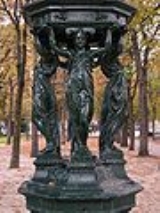
Wallace fountain
Encyclopedia
Wallace fountains are public drinking fountains designed by Charles-Auguste Lebourg that appear in the form of small cast-iron sculptures scattered throughout the city of Paris
, France
, mainly along the most-frequented sidewalks. They are named after the Englishman Richard Wallace, who financed their construction. A great aesthetic success, they are recognized worldwide as one of the symbols of Paris.
, Paris went through difficult times. The city was quickly rebuilt, despite the ravages it had suffered. In less than ten years, it was transformed, with new buildings (the Paris Opera
, for example) and new boulevards (the Raspail
and the St-Germain
). Additionally, philanthropy
was in fashion among the wealthy bourgeoisie
, who financed numerous "good works" (such as the Red Cross and the Salvation Army
) in order to uphold their image.
He founded a hospital, where he personally welcomed victims of the bombings and distributed supplies, among his other efforts on behalf of Parisians at war. He remained faithful to his adopted nation, France, and is buried at Père Lachaise cemetery.
Of his numerous contributions to Parisian heritage, the best known today are the fountains which bear his name.
episode, many aqueduct
s had been destroyed, and the price of water, already higher than normal, went up considerably. Because of this, most of the poor had to pay for water. The temptation to take to liquor was strong among the lower classes, and it was considered a moral duty to keep them from falling into alcoholism
. Even today, when water and hygiene are not a problem for the majority of Parisians, these fountains are often the only sources of free water for the homeless.
The poor are not the only beneficiaries of these installations. Even if the aim of the fountains was to allow people of modest means to have access to drinking water, they are not the only ones who use them. Anyone passing by, rich or poor, may quench his thirst, fulfilling this vital need in equal fashion.
Not only did the fountains accomplish Wallace's philosophy of lending a hand to those in need, but they also served to beautify Paris.
The locations, as well as the color (a dark green, like all urban development of that era, in order to blend in with the parks and tree-lined avenues), were quickly decided upon by the city government.
Wallace created two different models, which were followed by two additional models, so, in all, there were four types of Wallace fountains varying in such properties as height and motif. The material that was used to create them was cast-iron. Inexpensive, easy to mold, and robust, it was one of the most popular materials of the age. The majority of the cost was paid for by Wallace. The city of Paris allocated 1,000 francs for the large model and 450 francs for the wall-mounted model.
whom he knew and whose talents were already renowned. Lebourg improved Wallace's sketches, already studied and thought-provoking, to make the fountains true works of art.
The large model was conceived by Sir Richard Wallace, and was inspired by the Fontaine des Innocents
. On a foundation of Hauteville stone rests an octagonal pedestal on which four caryatid
s are affixed with their backs turned and their arms supporting a pointed dome
decorated by dolphins.
The water is distributed in a slender trickle issuing from the center of the dome and falls down into a basin that is protected by a grille. To make distribution easier, two tin-plated, iron cups attached to the fountain by a small chain were at the drinker's desire, staying always submerged for more cleanliness. These cups were removed in 1952 "for Hygiene reasons" by demand of the Council of Public Hygiene of the old Department of the Seine.
For more information, see the Technical File (in French).
The four caryatids represent kindness
, simplicity
, charity
and sobriety
. Each one is different from her sisters, by the way she bends her knees and by where her tunic is tucked into her blouse.
The four caryatids
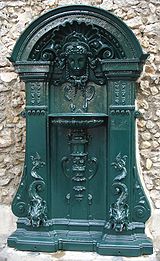 Sir Richard's other model. In the middle of a semi-circular pediment
Sir Richard's other model. In the middle of a semi-circular pediment
, the head of a naiad issues a trickle of water that falls into a basin resting between two pilasters. Two goblets allowed the water to be drunk, but they were retired under edict of the 1952 law cited above. This model, costing little to install, was to have been many units along the lengths of the walls of buildings with strong humanitarian focus, e.g. hospitals. This was unfortunately not the case and they do not remain today except for one situated on rue Geoffroy Saint-Hilaire.
Measuring only 4'-3" and weighing 286 lbs., they were commissioned by the mayor of Paris more frequently than its older sister models.
This model was the last to be realized. The general shape resembles that of the Large Model and the caryatids were replaced with small columns to reduce the cost of fabrication. The dome was also less pointy and the lower part more curved.
Although thirty models were made, today there remain only two, one on rue de Rémusat and the other on avenue des Ternes.
. They needed to be placed at the will of the public in a practical manner and integrated in the most harmonious fashion with the environment. Most were placed in squares or at the intersections of two roads. This made Eugene Belgrand (a hydraulic engineer, Director of Water and Sewers of Paris; he worked with the prefect Georges Haussmann) responsible for the choice, and one can consider that they were made in a judicious manner.
However, the more recent designs aren't strongly steeped in Wallace's aesthetic ideals, that in true Renaissance
style, they should be useful, beautiful, and symbolic, in addition to being real works of art. The disappearance of the faces of women is a good example of this (the feminine presence in Wallace's notions, an omnipresent symbol in Renaissance art, drew a parallel between water and woman, both mothers, tender and sensuous).
The fountains work from 15 March to 15 November (the risk of freezing during the months of winter would imperil the internal plumbing), are regularly maintained, and repainted every two years.
They are an integral part of the Parisian landscape, typical and picturesque, of the same importance as the Eiffel Tower
or the street urchins of Montmartre
, as their creators would have wished. In Amélie
, the cinegraphic piece about the glory of Parisian folklore, Jean-Pierre Jeunet
baptised a personality Madeleine Wallace (she cried like a madeleine, or like a Wallace fountain), although the English subtitled version renamed the character of Madeleine, to Madeleine Wells for cultural understanding.
For more than a century they have been in place, and these monuments have never had to suffer criticism. They were always respected. However, curiously, they are not classified as "historic monuments".
4th arrondissement
5th arrondissement
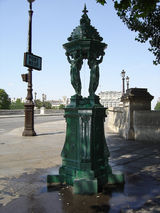 6th arrondissement
6th arrondissement
8th arrondissement
9th arrondissement
10th arrondissement
11th arrondissement
12th arrondissement
13th arrondissement
14th arrondissement
15th arrondissement
16th arrondissement
17th arrondissement
18th arrondissement
19th arrondissement
20th arrondissement
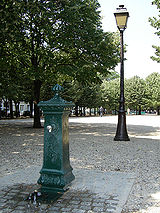 7th arrondissement
7th arrondissement
11th arrondissement
13th arrondissement
15th arrondissement
17th arrondissement
17th arrondissement
Nantes
The sculptor who created the fountains, Charles Auguste Lebourg, was originally from Nantes. In addition to the Parisian fountains, a few were placed in Nantes in honor of their creator:
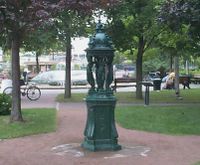
Bordeaux
On 6 October 1873, another philanthropist, Daniel Osiris, ordered six Large Model Fountains and asked the community of Bordeaux to install them. They are to be found at:
, who had them in his ownership in Marnes-la-Coquette
, and Brigitte Bardot
.
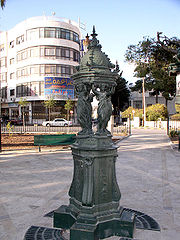 Outside France, one can find them in other countries including Switzerland
Outside France, one can find them in other countries including Switzerland
, Mozambique
, South Africa
, Canada
, Jordan
, Brazil
, United Kingdom (outside Hertford House which houses The Wallace Collection and at Lisburn
in Northern Ireland
), Grenada
in the West Indies, USA (New Orleans), Spain (Barcelona
) and Portugal (Lisbon
).
Montreal
Quebec
is known as 和麗女神噴泉 in Chinese and A Fonte Wallace in Portuguese.
Paris
Paris is the capital and largest city in France, situated on the river Seine, in northern France, at the heart of the Île-de-France region...
, France
France
The French Republic , The French Republic , The French Republic , (commonly known as France , is a unitary semi-presidential republic in Western Europe with several overseas territories and islands located on other continents and in the Indian, Pacific, and Atlantic oceans. Metropolitan France...
, mainly along the most-frequented sidewalks. They are named after the Englishman Richard Wallace, who financed their construction. A great aesthetic success, they are recognized worldwide as one of the symbols of Paris.
Background
During the Franco-Prussian WarFranco-Prussian War
The Franco-Prussian War or Franco-German War, often referred to in France as the 1870 War was a conflict between the Second French Empire and the Kingdom of Prussia. Prussia was aided by the North German Confederation, of which it was a member, and the South German states of Baden, Württemberg and...
, Paris went through difficult times. The city was quickly rebuilt, despite the ravages it had suffered. In less than ten years, it was transformed, with new buildings (the Paris Opera
Palais Garnier
The Palais Garnier, , is an elegant 1,979-seat opera house, which was built from 1861 to 1875 for the Paris Opera. It was originally called the Salle des Capucines because of its location on the Boulevard des Capucines in the 9th arrondissement of Paris, but soon became known as the Palais Garnier...
, for example) and new boulevards (the Raspail
Boulevard Raspail
Boulevard Raspail is a boulevard of Paris, in France.Its orientation is north-south, and joins boulevard Saint-Germain with place Denfert-Rochereau whilst traversing 7th, 6th and 14th arrondissements...
and the St-Germain
Boulevard Saint-Germain
The Boulevard Saint-Germain is a major street in Paris on the Left Bank of the Seine river. It curves in a 3.5 kilometer arc from the Pont de Sully in the east to the Pont de la Concorde in the west and traverses the 5th, 6th and 7th arrondissements...
). Additionally, philanthropy
Philanthropy
Philanthropy etymologically means "the love of humanity"—love in the sense of caring for, nourishing, developing, or enhancing; humanity in the sense of "what it is to be human," or "human potential." In modern practical terms, it is "private initiatives for public good, focusing on quality of...
was in fashion among the wealthy bourgeoisie
Bourgeoisie
In sociology and political science, bourgeoisie describes a range of groups across history. In the Western world, between the late 18th century and the present day, the bourgeoisie is a social class "characterized by their ownership of capital and their related culture." A member of the...
, who financed numerous "good works" (such as the Red Cross and the Salvation Army
Salvation Army
The Salvation Army is a Protestant Christian church known for its thrift stores and charity work. It is an international movement that currently works in over a hundred countries....
) in order to uphold their image.
Sir Richard Wallace
Among these philanthropists, Sir Richard Wallace was one of the most eclectic and reserved. Having inherited a large fortune from his father in August 1870, he decided that all Parisians should profit from it, which made him popular. Wallace's devotion led him to remain in his Parisian villa even as the city was besieged, rather than take refuge on one of his palatial estates, to be in Paris when he was needed.He founded a hospital, where he personally welcomed victims of the bombings and distributed supplies, among his other efforts on behalf of Parisians at war. He remained faithful to his adopted nation, France, and is buried at Père Lachaise cemetery.
Of his numerous contributions to Parisian heritage, the best known today are the fountains which bear his name.
Why fountains?
As a result of the siege of Paris and the CommuneParis Commune
The Paris Commune was a government that briefly ruled Paris from March 18 to May 28, 1871. It existed before the split between anarchists and Marxists had taken place, and it is hailed by both groups as the first assumption of power by the working class during the Industrial Revolution...
episode, many aqueduct
Aqueduct
An aqueduct is a water supply or navigable channel constructed to convey water. In modern engineering, the term is used for any system of pipes, ditches, canals, tunnels, and other structures used for this purpose....
s had been destroyed, and the price of water, already higher than normal, went up considerably. Because of this, most of the poor had to pay for water. The temptation to take to liquor was strong among the lower classes, and it was considered a moral duty to keep them from falling into alcoholism
Alcoholism
Alcoholism is a broad term for problems with alcohol, and is generally used to mean compulsive and uncontrolled consumption of alcoholic beverages, usually to the detriment of the drinker's health, personal relationships, and social standing...
. Even today, when water and hygiene are not a problem for the majority of Parisians, these fountains are often the only sources of free water for the homeless.
The poor are not the only beneficiaries of these installations. Even if the aim of the fountains was to allow people of modest means to have access to drinking water, they are not the only ones who use them. Anyone passing by, rich or poor, may quench his thirst, fulfilling this vital need in equal fashion.
Not only did the fountains accomplish Wallace's philosophy of lending a hand to those in need, but they also served to beautify Paris.
Conception
Richard Wallace designed the fountains himself and intended them to be beautiful as well as useful. The fountains had to meet several strict guidelines:- Height: They had to be tall enough to be seen from afar but not so tall as to destroy the harmony of the surrounding landscape.
- Form: Both practical to use and pleasing to the eye.
- Price: Affordable enough to allow the installation of dozens.
- Materials: Resistant to the elements, easy to shape, and simple to maintain.
The locations, as well as the color (a dark green, like all urban development of that era, in order to blend in with the parks and tree-lined avenues), were quickly decided upon by the city government.
Wallace created two different models, which were followed by two additional models, so, in all, there were four types of Wallace fountains varying in such properties as height and motif. The material that was used to create them was cast-iron. Inexpensive, easy to mold, and robust, it was one of the most popular materials of the age. The majority of the cost was paid for by Wallace. The city of Paris allocated 1,000 francs for the large model and 450 francs for the wall-mounted model.
Sculptor
Wishing that his project be completed as rapidly as possible, Wallace called on Charles-Auguste Lebourg, a sculptor from NantesNantes
Nantes is a city in western France, located on the Loire River, from the Atlantic coast. The city is the 6th largest in France, while its metropolitan area ranks 8th with over 800,000 inhabitants....
whom he knew and whose talents were already renowned. Lebourg improved Wallace's sketches, already studied and thought-provoking, to make the fountains true works of art.
Large model
(2.71 m, 610 kg)The large model was conceived by Sir Richard Wallace, and was inspired by the Fontaine des Innocents
Fontaine des Innocents
The Fontaine des Innocents is a monumental public fountain located on the place Joachim-du-Bellay in the Les Halles district in the 1st arrondissement of Paris, France. Originally called the Fountain of the Nymphs, it was constructed between 1547 and 1550 by architect Pierre Lescot and sculptor...
. On a foundation of Hauteville stone rests an octagonal pedestal on which four caryatid
Caryatid
A caryatid is a sculpted female figure serving as an architectural support taking the place of a column or a pillar supporting an entablature on her head. The Greek term karyatides literally means "maidens of Karyai", an ancient town of Peloponnese...
s are affixed with their backs turned and their arms supporting a pointed dome
Dome
A dome is a structural element of architecture that resembles the hollow upper half of a sphere. Dome structures made of various materials have a long architectural lineage extending into prehistory....
decorated by dolphins.
The water is distributed in a slender trickle issuing from the center of the dome and falls down into a basin that is protected by a grille. To make distribution easier, two tin-plated, iron cups attached to the fountain by a small chain were at the drinker's desire, staying always submerged for more cleanliness. These cups were removed in 1952 "for Hygiene reasons" by demand of the Council of Public Hygiene of the old Department of the Seine.
For more information, see the Technical File (in French).
The four caryatids represent kindness
Kindness
Kindness is the act or the state of being kind, being marked by good and charitable behaviour, pleasant disposition, and concern for others. It is known as a virtue, and recognized as a value in many cultures and religions ....
, simplicity
Simplicity
Simplicity is the state or quality of being simple. It usually relates to the burden which a thing puts on someone trying to explain or understand it. Something which is easy to understand or explain is simple, in contrast to something complicated...
, charity
Charity (virtue)
In Christian theology charity, or love , means an unlimited loving-kindness toward all others.The term should not be confused with the more restricted modern use of the word charity to mean benevolent giving.- Caritas: altruistic love :...
and sobriety
Sobriety
Sobriety is the condition of not having any measurable levels, or effects from, alcohol or other drugs that alter ones mood or behaviors. According to WHO "Lexicon of alcohol and drug terms..." sobriety is continued abstinence from alcohol and psychoactive drug use...
. Each one is different from her sisters, by the way she bends her knees and by where her tunic is tucked into her blouse.
Applied model
(1.96 m, 300 kg)
Pediment
A pediment is a classical architectural element consisting of the triangular section found above the horizontal structure , typically supported by columns. The gable end of the pediment is surrounded by the cornice moulding...
, the head of a naiad issues a trickle of water that falls into a basin resting between two pilasters. Two goblets allowed the water to be drunk, but they were retired under edict of the 1952 law cited above. This model, costing little to install, was to have been many units along the lengths of the walls of buildings with strong humanitarian focus, e.g. hospitals. This was unfortunately not the case and they do not remain today except for one situated on rue Geoffroy Saint-Hilaire.
Small model
These are simple pushbutton fountains that one can find in squares and public gardens and are marked with the Parisian Seal (although the one installed on the Place des Invalides doesn't have this seal). They are very familiar to mothers who bring their children to play in the many small parks in Paris.Measuring only 4'-3" and weighing 286 lbs., they were commissioned by the mayor of Paris more frequently than its older sister models.
Colonnaded model
(2.50 m, a little more than 500 kg)This model was the last to be realized. The general shape resembles that of the Large Model and the caryatids were replaced with small columns to reduce the cost of fabrication. The dome was also less pointy and the lower part more curved.
Although thirty models were made, today there remain only two, one on rue de Rémusat and the other on avenue des Ternes.
Where to place them?
The choice of the location of the fountains was left to the city of ParisParis
Paris is the capital and largest city in France, situated on the river Seine, in northern France, at the heart of the Île-de-France region...
. They needed to be placed at the will of the public in a practical manner and integrated in the most harmonious fashion with the environment. Most were placed in squares or at the intersections of two roads. This made Eugene Belgrand (a hydraulic engineer, Director of Water and Sewers of Paris; he worked with the prefect Georges Haussmann) responsible for the choice, and one can consider that they were made in a judicious manner.
Wallace fountains
The first two models (large model and applied model) were conceived and financed by Sir Richard Wallace, from whom they get their name. The two other models were created in the same styles and the resemblance is obvious. They were created following the success of their predecessors.However, the more recent designs aren't strongly steeped in Wallace's aesthetic ideals, that in true Renaissance
Renaissance
The Renaissance was a cultural movement that spanned roughly the 14th to the 17th century, beginning in Italy in the Late Middle Ages and later spreading to the rest of Europe. The term is also used more loosely to refer to the historical era, but since the changes of the Renaissance were not...
style, they should be useful, beautiful, and symbolic, in addition to being real works of art. The disappearance of the faces of women is a good example of this (the feminine presence in Wallace's notions, an omnipresent symbol in Renaissance art, drew a parallel between water and woman, both mothers, tender and sensuous).
Today
Most of the fountains still present in the city still work, and distribute, contrary to popular belief, perfectly potable water. They are the rare points of free water in the city to the great relief of the homeless for whom they are a life-source and the thirst of passers-by which the fountains often quench. Sir Richard Wallace has achieved his goal and probably fulfilled his hopes.The fountains work from 15 March to 15 November (the risk of freezing during the months of winter would imperil the internal plumbing), are regularly maintained, and repainted every two years.
They are an integral part of the Parisian landscape, typical and picturesque, of the same importance as the Eiffel Tower
Eiffel Tower
The Eiffel Tower is a puddle iron lattice tower located on the Champ de Mars in Paris. Built in 1889, it has become both a global icon of France and one of the most recognizable structures in the world...
or the street urchins of Montmartre
Montmartre
Montmartre is a hill which is 130 metres high, giving its name to the surrounding district, in the north of Paris in the 18th arrondissement, a part of the Right Bank. Montmartre is primarily known for the white-domed Basilica of the Sacré Cœur on its summit and as a nightclub district...
, as their creators would have wished. In Amélie
Amélie
Amélie is a 2001 romantic comedy film directed by Jean-Pierre Jeunet. Written by Jeunet with Guillaume Laurant, the film is a whimsical depiction of contemporary Parisian life, set in Montmartre...
, the cinegraphic piece about the glory of Parisian folklore, Jean-Pierre Jeunet
Jean-Pierre Jeunet
-Life and career:Jean-Pierre Jeunet was born in Roanne, Loire, France. He bought his first camera at the age of 17 and made short films while studying animation at Cinémation Studios. He befriended Marc Caro, a designer and comic book artist who became his longtime collaborator and...
baptised a personality Madeleine Wallace (she cried like a madeleine, or like a Wallace fountain), although the English subtitled version renamed the character of Madeleine, to Madeleine Wells for cultural understanding.
For more than a century they have been in place, and these monuments have never had to suffer criticism. They were always respected. However, curiously, they are not classified as "historic monuments".
The 67 large model fountains
3rd arrondissementArrondissement
Arrondissement is any of various administrative divisions of France, certain other Francophone countries, and the Netherlands.-France:The 101 French departments are divided into 342 arrondissements, which may be translated into English as districts. The capital of an arrondissement is called a...
- Boulevard de Sébastopol, square Chautemps
- Passage du Pont aux biches
- Rue de la corderie, place Nathalie Lemel
4th arrondissement
- Place Louis Lépine, next to the Chambre de Commerce
- Place Louis Lépine, next to the Hôtel-dieu
- 7, Boulevard du Palais
- 123, rue Saint-Antoine
5th arrondissement
- Rue Poliveau, face rue de l'Essai
- Place Maubert
- 37, rue de la BûcherieRue de la BûcherieRue de la Bûcherie is a street in Paris, France.- History :Near the cathedral Notre-Dame de Paris and the Place Maubert, between La Seine and Boulevard Saint-GermainThe Rue de la Bûcherie is one of Paris' oldest Rive Gauche streets....
- Place des Patriarches

- Place Saint-Germain-des-Prés
- Place Saint-SulpicePlace Saint-SulpiceThe large public space at the Place Saint Sulpice, which is dominated on its eastern side by the church of Saint-Sulpice, was built in 1754 as a tranquil garden in the Latin Quarter of the 6th arrondissement of Paris.-Attractions of the square:...
- Pont Neuf, Quai des Grands Augustins
- Rue Vavin, at rue Bréa
- Place Saint-André-des-Arts
8th arrondissement
- Rue de St-Pétersbourg, at rue de Turin
- Av. des Champs-Elysées, Chevaux de Marly (north side)
- Av. des Champs-Elysées, Chevaux de Marly (south side)
9th arrondissement
- Place Gustave Toudouze
- Place de Budapest
10th arrondissement
- Place Juliette Dodu
- Place Jacques Bonsergent
- Place Robert Desnos
11th arrondissement
- 143, rue de la Roquette
- 197, Boulevard Voltaire
- 44, rue Jean-Pierre Timbaud
- 94, rue Jean-Pierre Timbaud
- 1, Boulevard Richard Lenoir
- 89, Boulevard Richard Lenoir
12th arrondissement
- Cours de Vincennes, face Blvd de Picpus
- Angle de St-Mandé, at rue du Rendez-vous
- Rue Descot, face Mairie du XIIe arrondissmentt
13th arrondissement
- 82, avenue d'Italie
- Rue de la Butte-aux-cailles, at rue de l'Espérance
- ZAC Baudricourt, at avenue d'Ivry
14th arrondissement
- Avenue Reille, at avenue René Coty
- Place Jules Hénaffe
- Place Edgard quinet, at rue de la Gaîté
- Place Denfert-Rochereau, at Blvd Raspail
- Avenue du Maine, face Mairie du XIVè arrondissement
15th arrondissement
- Place Henri Rollet
- 2, boulevard Pasteur
- Place du Général Beuret
- Place Charles Vallin
16th arrondissement
- 10, boulevard Delessert
- 194, avenue de Versailles
- Place Jean Lorrain
- Place de Passy
- Place du Père Marcellin Campagnat
17th arrondissement
- 112, avenue de Villiers
- Place Aimé Maillard
- 15, avenue Niel
- 1, avenue de Wagram
- 112, boulevard des Batignolles
18th arrondissement
- Place Emile Goudeau
- 42, boulevard Rochechouart
- Rue Saint-Eleuthère, at rue Azaïs
- Place des Abbesses
- Rue de la Goutte d'or, at rue de Chartres
19th arrondissement
- 214, boulevard de la Villette
- 139, Rue Meaux at Rue du Rhin
20th arrondissement
- Place Edith Piaf
- 6, rue Eugène Belgrand
- 29, boulevard de Ménilmontant
- Place Maurice Chevalier
- Rue Piat, face au square
The 9 small model fountains

- Place des Invalides
11th arrondissement
- 32, boulevard Richard Lenoir
- 74, boulevard Richard Lenoir
13th arrondissement
- Place Paul Verlaine
15th arrondissement
- Place Alain Chartier
- Place Saint Charles
- 19, Place du Commerce
- 35, boulevard Pasteur
17th arrondissement
- 5, Place de Lévis
The 2 colonnaded fountains
16th arrondissement- Rue de Rémusat, at Rue de Mirabeau
17th arrondissement
- Avenue des Ternes, at Place Pierre Demours
The applied model
5th arrondissement- Intersection of Rue Geoffroy Saint-Hilaire and rue Cuvier
NantesNantesNantes is a city in western France, located on the Loire River, from the Atlantic coast. The city is the 6th largest in France, while its metropolitan area ranks 8th with over 800,000 inhabitants....
The sculptor who created the fountains, Charles Auguste Lebourg, was originally from Nantes. In addition to the Parisian fountains, a few were placed in Nantes in honor of their creator:- Place de la Bourse
- Parc de la Gaudinière
- Jardin des plantes, near the botanical garden
- Jardin des Plantes, Boulevard Stalingrad, bas du jardin, near the entrance to "Gare SNCF"
- Cours Cambronne

BordeauxBordeauxBordeaux is a port city on the Garonne River in the Gironde department in southwestern France.The Bordeaux-Arcachon-Libourne metropolitan area, has a population of 1,010,000 and constitutes the sixth-largest urban area in France. It is the capital of the Aquitaine region, as well as the prefecture...
On 6 October 1873, another philanthropist, Daniel Osiris, ordered six Large Model Fountains and asked the community of Bordeaux to install them. They are to be found at:- Place du Général Sarrail
- Place Mitchell (Mitchell was an Irishman who founded the city's first glassworks in rue de la Verrerie, creating the wine bottles that enabled the city to launch its international wine export trade)
- Cours Xavier Arnozan (ex. Pavé des Chartrons)
- Place Jacques Le Moine
- Jardin Public
- Corner rue Ste Cathérine/rue Paul Broca
Pau
- Corner boulevard de la Paix and avenue de Buros
Private ownership
Some rich people and art amateurs, as well as celebrity artists, bought them for their pleasure. This was the case with Maurice ChevalierMaurice Chevalier
Maurice Auguste Chevalier was a French actor, singer, entertainer and a noted Sprechgesang performer. He is perhaps best known for his signature songs, including Louise, Mimi, Valentine, and Thank Heaven for Little Girls and for his films including The Love Parade and The Big Pond...
, who had them in his ownership in Marnes-la-Coquette
Marnes-la-Coquette
Marnes-la-Coquette is a commune in the western suburbs of Paris, France. Located from the center of Paris, the town is situated between the Parc de Saint-Cloud and the Forest of Fausses-Reposes...
, and Brigitte Bardot
Brigitte Bardot
Brigitte Anne-Marie Bardot is a French former fashion model, actress, singer and animal rights activist. She was one of the best-known sex-symbols of the 1960s.In her early life, Bardot was an aspiring ballet dancer...
.
Outside France

Switzerland
Switzerland name of one of the Swiss cantons. ; ; ; or ), in its full name the Swiss Confederation , is a federal republic consisting of 26 cantons, with Bern as the seat of the federal authorities. The country is situated in Western Europe,Or Central Europe depending on the definition....
, Mozambique
Mozambique
Mozambique, officially the Republic of Mozambique , is a country in southeastern Africa bordered by the Indian Ocean to the east, Tanzania to the north, Malawi and Zambia to the northwest, Zimbabwe to the west and Swaziland and South Africa to the southwest...
, South Africa
South Africa
The Republic of South Africa is a country in southern Africa. Located at the southern tip of Africa, it is divided into nine provinces, with of coastline on the Atlantic and Indian oceans...
, Canada
Canada
Canada is a North American country consisting of ten provinces and three territories. Located in the northern part of the continent, it extends from the Atlantic Ocean in the east to the Pacific Ocean in the west, and northward into the Arctic Ocean...
, Jordan
Jordan
Jordan , officially the Hashemite Kingdom of Jordan , Al-Mamlaka al-Urduniyya al-Hashemiyya) is a kingdom on the East Bank of the River Jordan. The country borders Saudi Arabia to the east and south-east, Iraq to the north-east, Syria to the north and the West Bank and Israel to the west, sharing...
, Brazil
Brazil
Brazil , officially the Federative Republic of Brazil , is the largest country in South America. It is the world's fifth largest country, both by geographical area and by population with over 192 million people...
, United Kingdom (outside Hertford House which houses The Wallace Collection and at Lisburn
Lisburn
DemographicsLisburn Urban Area is within Belfast Metropolitan Urban Area and is classified as a Large Town by the . On census day there were 71,465 people living in Lisburn...
in Northern Ireland
Northern Ireland
Northern Ireland is one of the four countries of the United Kingdom. Situated in the north-east of the island of Ireland, it shares a border with the Republic of Ireland to the south and west...
), Grenada
Grenada
Grenada is an island country and Commonwealth Realm consisting of the island of Grenada and six smaller islands at the southern end of the Grenadines in the southeastern Caribbean Sea...
in the West Indies, USA (New Orleans), Spain (Barcelona
Barcelona
Barcelona is the second largest city in Spain after Madrid, and the capital of Catalonia, with a population of 1,621,537 within its administrative limits on a land area of...
) and Portugal (Lisbon
Lisbon
Lisbon is the capital city and largest city of Portugal with a population of 545,245 within its administrative limits on a land area of . The urban area of Lisbon extends beyond the administrative city limits with a population of 3 million on an area of , making it the 9th most populous urban...
).
Canada
GranbyGranby, Quebec
Granby is a city in southwestern Quebec, located east of Montreal. The population as of the Canada 2006 Census was 47,637. Granby is the seat of La Haute-Yamaska Regional County Municipality. It is the fifth most populated city in Montérégie after Longueuil, Saint-Jean-sur-Richelieu, Brossard and...
- In Isabelle Park, on the corner of rue Dufferin and boulevard Leclerc. Installed in 1956, the fountain was a gift from France to celebrate Granby's "French Week".
Montreal
- Île Notre-DameÎle Notre-DameÎle Notre-Dame is an artificial island built in 10 months from 15 million tons of rock excavated for the Montreal Metro in 1965. It was created for Expo 67 to celebrate Canada's centennial. The island is part of the city of Montreal and forms part of the Hochelaga Archipelago...
, Parc des Îles, Jardin de la France, Montreal. This fountain was offered to the City of Montréal by the city of Paris in 1980 during the 1980 International Floralies fair held in Montreal.
Quebec
- One at the intersection of Grande-Allée and rue Cartier; another on rue Saint-Paul, by the turning to ruelle Légaré.
Macau (China)
The Wallace Fountain in MacauMacau
Macau , also spelled Macao , is, along with Hong Kong, one of the two special administrative regions of the People's Republic of China...
is known as 和麗女神噴泉 in Chinese and A Fonte Wallace in Portuguese.
- Inside Jardim de S. Francisco on Rua do Campo, set up in 2004
- Between Rua do Regedor and Rua Correia da Silva of Taipa Village, set up in 2005
Further reading
- Marie-Hélène Levadé and Hugues Marcouyeau, Les fontaines de Paris : l'eau pour le plaisir. Paris, 2008 ISBN 9782915345056
- Daniel Rabreau, Paris et ses fontaines. Paris, 1997 ISBN 9782905118806

